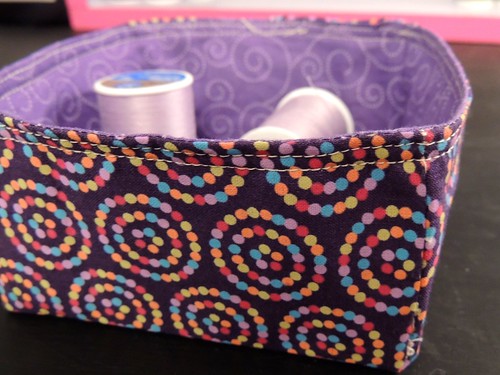Today I am going to show you how to make this skirt - a lined gathered skirt with an elastic waist and pockets!
NB: The numbered steps correspond to the numbered pictures. Not every step has a picture, but it's pretty easy to figure out!
1. Gather supplies.
For a 19inch long skirt with a 0-42inch waist, you will need:
1 1/2 yard main fabric
1 yard lining fabric
1inch elastic equal to your waist minus 1 inch
2. Cut fabric!
You will need to measure your waist (or hips, or wherever you want the skirt to sit).
Take that measurement, and cut two waist width x 23 inch rectangles out of your main skirt fabric. (This is easily accomplished by laying the fabric folded selvage-to-selvage and cutting 23 inch rectangles across the width of the fabric, and then subcutting those 23 inch by selvage-to-selvage (roughly 44) into 23 inch by your waist size rectangles.
Cut the lining fabric into 22 inch by your waist size rectangles.
(This is easily accomplished by laying the fabric folded with the fold lined up with a line on your cutting board, and cutting a selvage-to-selvage by your waist width rectangle. Then subcut that rectangle into two 22 inch rectangles).
3. Cut 4 pocket shapes out of the main fabric. (I used
the pattern by See Kate Sew but you can draw your own pocket in any size you want).
You will also need to cut your elastic to your waist width minus one inch.
Sew side seams (the 22inch side) of lining fabric right-sides-together with a 1/4inch seam allowance.
You should end up with a giant rectangular tube of fabric. Like a skirt, but huge and unfashionable.
5. Sew the pocket shapes to the 23inch sides of your main fabric 2 inches from the top of the fabric with right sides together.
6. Press the pockets outward away from the fabric.
7. Topstitch the pockets in place with a 1/8inch seam allowance.
8. Sew up the side seams of the main fabric right-sides-together and sew around the pockets with a 1/4inch seam allowance.
You should be making a straight line down two inches, then around the pocket shape, then straight down the rest of the side seam.
You should end up with another huge rectangular tube, but with pockets!
9. Attach the sewn lining to the sewn main fabric by placing the the main fabric inside the lining with the wrong sides together.
Match the side seams.
The lining fabric will be shorter than the main fabric. Line up the top of the lining fabric rectangular tube with the top of the main fabric rectangular tube.
Sew around the top with a 1/4inch seam allowance.
(This will attach the lining to the main fabric with the seams nicely captured inside._
Fold over the top of the now-attached lining and main fabric 1/4inch (so just about that line you just sewed up!).
Press.
Fold over again 1 1/4inch (if you are using 1" wide elastic. If not, use the measurement of your elastic plus 1/4inch).
Press.
Topstitch along the bottom edge of your folded-over top.
Leave a 3inch gap near one of the seams.
Fold over the hem (so the bottom edge, not the one you just sewed!) 1/2inch.
Press.
Fold again 1 1/4inch.
Topstitch along the top edge of the folded-over hem.
Topstitch again 1/4inch from the line you just sewed.
Thread the elastic through the top of the skirt.
Attach a safety pin to one end of the elastic. Close the safety pin and thread through the tube you created at the top of the skirt. Hold onto the other end of the elastic so it doesn't disappear into the skirt also!
Once the elastic is threaded through, sew the ends of the elastic together. Stitch up the gap.
Put on the skirt and adjust the gathers. Stitch down the sides of the elastic, connecting the side seams up to the top of the skirt. This will keep the elastic from sifting around.
Wash, enjoy, and wear!




















































